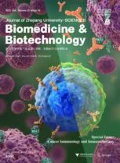Abstract
The effect of tea saponins (TS) on rumen fermentation and methane emission was examined using an in vitro gas production technique named Reading Pressure Technique. Three levels of TS addition (0, 0.2, 0.4 mg/ml) were evaluated in the faunated and defaunated rumen fluid. Compared to the control, TS addition decreased the 24 h gas production in the faunated rumen fluid, but had a minor effect on gas yield in the defaunated rumen fluid. The TS significantly reduced methane production in vitro. In the faunated rumen fluid, 0.2 or 0.4 mg/ml TS decreased the 24 h methane emission by 12.7% or 14.0%, respectively. Rumen fluid pH value was affected neither by TS addition nor by defaunation. The TS addition had only minor effects on volatile fatty acids, but the yield and pattern of volatile fatty acids were greatly affected by defaunation. While the molar proportion of acetate was not affected by defaunation, the propionate was significantly increased and the butyrate significantly decreased. Ammonia-N concentration and microbial protein yield were influenced by TS inclusion and defaunation. Inclusion of 0.4 mg/ml TS increased the microbial protein mass by 18.4% and 13.8% and decreased the ammonia-N concentration by 8.3% and 19.6% in the faunated and defaunated rumen fluid, respectively. Protozoa counts were significantly reduced by TS inclusion. The current study demonstrated the beneficial effect of TS on methane production and rumen fermentation, and indicated that this may be due to the effect of the associated depression on protozoa counts.
Similar content being viewed by others
References
Dohme, F., Machmuller, A., Estermann, B.L., Pfister, P., Wasserfallen, A., Kreuzer, M., 1999. The role of the rumen ciliate protozoa for methane suppression caused by coconut oil.Letters of Applied Microbialogy,29:187–192.
Feng, Z.C., Gao, M., 1993. The determination of ammonia nitrogen concentration in the rumen fluid by a colorimetric method.Inner Mongolian J. of Anim. Sci. and Produc.,4:40–41 (in Chinese).
Finlay, B.J., Esteban, G., Clarke, K.J., Williams, A.G., Embley, T.M., Hirt, R.P., 1994. Some rumen ciliates have endosymbiotic methanogens.FEMS Microbiology Letters.117:157–162.
Hess, H.D., Kreuzer, M., Diaz, T.E., Lascano, C.E., Carulla, J.E., Soliva, C.R., Machmuller, A., 2003. Saponin rich tropical fruits affect fermentation and methanogensesis in faunated and defaunated rumen fluid.Animal Feed Science and Technology,109:79–94.
Hristov, N.A., McAllister, T.A., van Herk, F.H., Cheng, K.J., Newbold, C.J., Cheeke, P.R., 1999. Effect of Yucca schidigera on ruminal fermentation and nutrient digestion in heifers.Journal of Animal Science,77:2554–2563.
IPCC (Intergoverment Panel on Climate Change), 2001. Climate Change 2001. The Scientific Basis. Cambridge University Press, Cambridge, UK.
Johnson, K.A., Johnson, D.E., 1995. Methane emissions from cattle.J. Anim. Sci.,73:2483–2492.
Jouany, J.P., 1996. Effect of rumen protozoa on nitrogen utilization by ruminants.Journal of Nutrition 126:1335–1346.
Klita, P.T., Mathison, G.W., Fenton, T.W., Hardin, R.T., 1996. Effects of alfalfa root saponins on digestive function in sheep.Journal of Animal Science,74:1144–1156.
Liu, J.X., Yuan, W.Z., Ye, J.A., Wu, Y.M., 2003. Effect of tea (Camellia sineis) saponin addition on rumen fermentation in vitro.Tropical Subtropical Agroecosystem,3:561–564.
Makkar, H.P.S., Becker, K., 1997. Degradation of Quillaja saponins by mixed culture of rumen microbes.Letters of Applied Microbialogy,25:243–245.
Makkar, H.P.S., Becker, K., 1999. Purine quantification in digesta from ruminants by spectrophotometric and HPLC methods.British Journal of Nutrition,81:107–113.
Mauricio, R.M., Mould, F.L., Dhanoa, M.S., Owen, E., Channa, K.S., Theodorou, M.K., 1999. A semi-automated in vitro gas production technique for ruminant feedstuff evaluation.Animal Feed Science and Technology,79:321–330.
Menke, K.H., Steingass, H., 1988. Estimation of the energetic feed value obtained from chemical analysis and in vitro gas production using rumen fluid.Animal Research Development,28:7–55.
Moss, A.R., Jouany, J.P., Newbold, J., 2000. Methane production by ruminants: Its contribution to global warming.Annal Zootechnology,49:231–253.
Ogimoto, K., Imai, S., 1981. Atlas of Rumen Microbiology. Japan Scientific Society Press, Tokyo, Japan, p. 311.
SAS (Statistical Analysis System), 1997. Base SAS Software Reference Card. Version 6.12, Cary, N.C., SAS Institute Inc., USA, p. 211–253.
Theodorou, M.K., Williams, B.A., Dhanoa, M.S., McAllan, A.B., France, J., 1994. A simple gas production method using a pressure transducer, to determine the fermentation kinetics of ruminant feeds.Animal Feed Science and Technology,48:185–197.
Wang, Y.X., McAllister, T.A., Newbold, C.J., Cheeke, P.R., Cheng, K.J., 1997. Effects of Yucca Extract on Fermentation and Degradation of Saponins in the Rusitec. Proceedings of Western Section, American Society of Animal Science, Vol. 48. Nashville, Tennessee, USA, p. 149–152.
Wang, Y.X., McAllister, T.A., Newbold, C.J., Rode, L.M., Cheeke, P.R., Cheng, K.J., 1998. Effect of Yucca schidigera extract on fermentation and degradation of steroidal saponins in the rumen simulation technique (RUSITEC).Animal Feed Science and Technology,74:143–153.
Wang, Y.X., McAllister, T.A., Yanke, L.J., Xu, Z.J., Cheeke, P.R., Cheng, K.J., 2000. In vitro effects of steroidal saponins from Yucca Schidigere extract on rumen microbial protein synthesis and ruminal fermentation.Journal of Science and Food Agriculture,80:2114–2122.
Whitelaw, F.G., Eadie, J.M., Bruce, L.A., Shand, W.J., 1984. Methane formation in faunated and ciliate-free cattle and its relationship with rumen volatile fatty acid proportions.British Journal of Nutrition,52:261–275.
Zinn, R.A., Owens, F.N., 1986. A rapid procedure for purine measurement and its use for estimating net ruminal protein synthesis.Canadian Journal of Animal Science,66:157–166.
Author information
Authors and Affiliations
Corresponding author
Additional information
Project (No. 12665/R0) supported partly by Co-ordinated Research Projects from Joint FAO/IAEA Division, IAEA
Rights and permissions
About this article
Cite this article
Wei-lian, H., Yue-ming, W., Jian-xin, L. et al. Tea saponins affect in vitro fermentation and methanogenesis in faunated and defaunated rumen fluid. J. Zheijang Univ.-Sci. B 6, 787–792 (2005). https://doi.org/10.1007/BF02842438
Received:
Accepted:
Issue Date:
DOI: https://doi.org/10.1007/BF02842438




